Konstantin Novoselov
Biographical
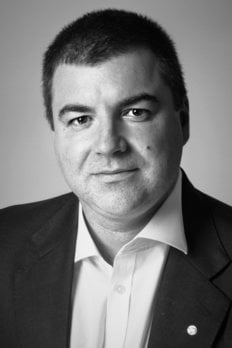
“Now, here, you see, it takes all the running you can do, to keep in the same place. If you want to get somewhere else, you must run at least twice as fast as that!”
Lewis Carroll, Through the Looking Glass
“Everything’s got a moral …”
Lewis Carroll, Alice’s Adventures in Wonderland
I was born in 1974 in Nizhnii Tagil, a middle-sized industrial city in the Ural Mountains in Russia. My mother, Tatiana Novoselova, was an English teacher at my school (though, in spite of all her efforts, I only started to speak, not even proper, but any English after I moved to the Netherlands), and my father, Sergey Novoselov, was an engineer at the local Factory.
The Factory – a huge enterprise the size of the city itself – was central to our life, even at the most basic level: every morning there would be a whistle loud enough to wake people several miles away at 7.00 am, two at 7.30 am to get people out of their homes, three at 8.00 am as a signal to start working and another at 4.30 pm when the workers could go home. It produced railway carriages and tanks, including the legendary T-34 (it was moved from the occupation zone of Kharkov during the Second World War), a fact I was very proud of despite the trouble it brought to our family (my granddad Gleb Komarov, a tank test-driver who was evacuated from Kharkov with the factory, lost his legs in an accident in his tank in 1944).
Having such high-technology industry in the vicinity meant there were large numbers of highly qualified engineers and specialist technicians around, and inevitably, our hobbies were rather technical as well. So, along with cross-country skiing, I was seriously into carting, mainly due to my father, who was himself into auto sports, and many parts of the cars were produced or modified by our own hands. Through this hobby, I learned bits of lathing, milling and welding, skills which I also put to use during summer placements at the factory.
I had always been quite technical. When I was eight, my father gave me a German model railway, and the part I used most was its variable DC power source, which came in handy in experiments from electrolysis to building electromagnets. With my parents working full time, and my seven-years-younger sister Elena in the nursery, I had a few hours after school each day to do ‘research’ such as looking for gunpowder recipes or casting metals and then cleaning up the kitchen afterwards.
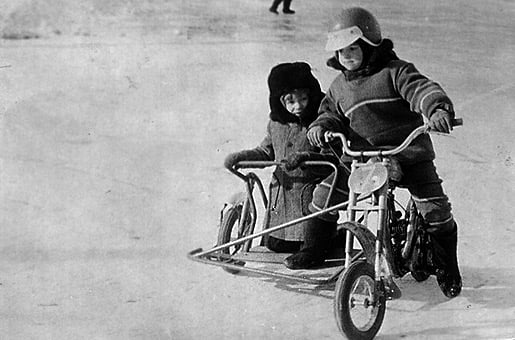
Figure 1. Myself (steering) and my friend Dima Zamiatin racing on ice track (approx. 1980).
The load on our kitchen was significantly reduced when I reached the higher grades, and my passion for such experiments was supported by my physics teacher, Ljudmila Rastorgueva, who allowed me free rein with the equipment in our school physics laboratory. She also, together with my maths teachers Valentina Filippova and Ljudmila Bashmakova, introduced me to the Distance Learning School of the Moscow Institute of Physics and Technology (Phystech), as well as pushing me to participate in physics and maths Olympiads at various levels. Other great sources of information and encouragement at this time were the monthly journal Quant, a series of fantastic books by the same publisher and translated texts by Martin Gardner. But, it would be wrong to suggest that I limited myself to physics and maths literature; quite a keen reader, my school-time favourites included Pasternak, Pushkin, Jack London, H.G. Wells, Jerome K. Jerome, Lewis Carroll and Mark Twain (though my tastes changed dramatically over time).
My participation in the Distance Learning School and Olympiads made entering Phystech in 1991 fairly straightforward. I chose the Faculty of Physical and Quantum Electronics and experienced an amazing and bizarre combination of the highest standards of education and rather tough living conditions. The curriculum was also quite intense, especially during the third year when one could easily spend ten straight hours a day in the lectures, tutorials and research labs. But with our courses given by the leading actively-working scientists, we felt privileged and extremely proud to study there.
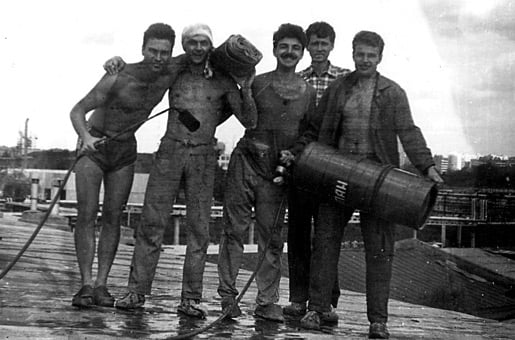
Figure 2. At this moment we were “heavily” involved in construction business in Moscow (1993). Left to right: Danil Melnikov, Konstantin Antipin, Kostya Novoselov, Vladimir Ryabenko, Sergey Lemekhov with Taras Taran pressing the button on the camera.
The Phystech students formed a very close and friendly community, and these connections helped us survive the turbulent times of 1991–95 in Russia. I remember, during one of the blackouts which were unfortunately very regular (especially during winter), Sasha Zhuromskii reading something from Tolkien using the last candle we could find and a good dozen people hanging around on the double-decker beds in our hostel room, which was small even for the four of us who lived there. Another source of entertainment, despite a continuous shortage of money on all of our parts, were regular visits to the Bolshoi Theatre, where we traded work as claqueurs (paid applauders) for a chance to see the performances.
Of course, there were quite a few temptations outside science and many alternative paths to take. In 1993, I participated in the October Putsch in Moscow, and it was quite an experience. I still feel lucky that they refused to give me a gun, despite my strong insistence. As a consequence, I decided that my revolutions would be in physics, definitely not politics – in fact I decided to stay as far away as possible from any politics at all. My romance with business was somewhat longer lasting: for about three years I was heavily involved with a construction company in parallel with my study (luckily the work was mostly during my summer breaks) and for some time it was good fun to learn another profession, meet new people and earn good money. But, after a while, I got bored, and when the question of science or business arose, I chose science; it is absolutely impossible to do ‘part-time science’, and I feel lucky that I realised that quite early in my career.
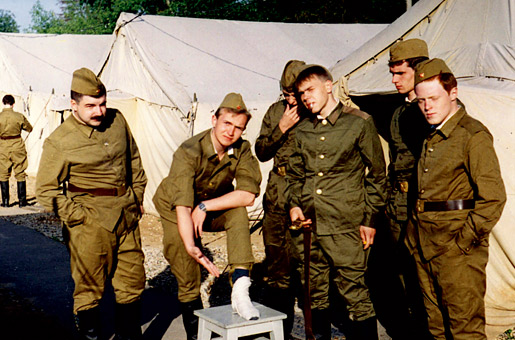
Figure 3. At the military camp (1996). The first lesson in the camp is to learn how to put the foot-binding properly (wearing boots require foot-binding rather than socks). Left to right: Kostya Novoselov, Alexander Fedichkin, Sergey Zhukov, Yurii Kapin, Misha Meleshkevich, Alexey Sobolev.
Phystech is rather different from other Russian universities. Science in the country is traditionally concentrated in research institutes and Phystech uses these as so-called ‘bases’, where students can follow specialised courses and get involved in research projects. Typically students spend about a day a week on a ‘base’ during their third year, with the proportion reaching 100% by their sixth year. My first base was Astrophysica, the State Research Centre originally focused on research into powerful laser systems and their use in military applications, but within a year I had decided that it was not what I wanted and moved to Chernogolovka’s Institute of Microelectronics Technology.
Chernogolovka is a very small town in the middle of a forest about sixty km east of Moscow, with 20,000 people and a dozen research institutes. I loved everything about it: the place itself looked amazing, especially during the winter (I would have to walk through the forest for a good half hour each day to get to the institute), the people were enthusiastic and passionate about science, and the range of courses we were offered was excellent. In addition, the lectures were given by the leading scientists at the Institute of Solid State Physics, the Landau Institute for Theoretical Physics and the Institute of Microelectronics Technology: Vsevolod Gantmakher, Vladislav Timofeev and Mikhail Trunin to name just three.
At Chernogolovka, I started to learn microelectronics technology (now it would be happily called ‘nanotechnology’) from Sergey Dubonos and worked with Zhenia Vdovin, Yura Khanin and Sergey Morozov on tunnelling spectroscopy [1] in the laboratory of the late Yura Dubrovskii. I learned so much from these people, from basic human communication skills to the most complicated experimental techniques. I remember that I so envied the skills with which Yura Khanin and Zhenia Vdovin handled the most miniscule samples that I asked a good friend of mine, Marina Dvinianina, to get me a cut-throat razor to develop the steadiness of my hands when shaving – it was quite a painful and bloody experience, but I soon achieved a less dangerous level of expertise.
In 1997, I was doing my PhD in the same lab [2] (and still shaving with the same razor, which I use to this day), when I got an opportunity to go to Nijmegen in the Netherlands to work with Andre Geim. Andre already had a reputation for being an innovative and creative experimentalist, so I didn’t think twice. During the spring of 1999, I spent a couple of months in Nijmegen as a probation period, where I did everything possible to disappoint Andre, once forgetting to close the lid on the helium dewar (which has never happened to me before or since) and using a ‘u’ instead of an ‘a’ in the phrase “last opportunity” when Andre asked me to write to a journalist for him from his e-mail account. Yet, despite all my “efforts” to sabotage my chances, I started my PhD with Andre in Professor Jan Kees Maan’s high magnetic field laboratory in August 1999.
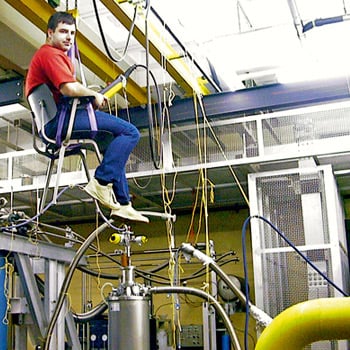
Figure 4. High magnetic field installation in Nijmegen is a huge enterprise and requires rather radical moves if something needs to be fixed (2000).
This was quite a different experience for me. The laboratory was large, international, had a huge variety of projects running [3–4] simultaneously, and always had visitors coming in for measurements on the high magnetic field installation. It certainly broadened my horizons in terms of science but unfortunately not with regards to Dutch: with our community being so international (my closest friends were Igor Shkliarevskii, Fabio Pulizzi and Cecilia Possanzini) we spoke quite a weird dialect of English, with a smattering of Italian, French, Dutch and Russian words and grammar lifted from Guy Ritchie’s movies Lock, Stock … and Snatch (kindly and patiently explained to us by A. Keen and A. Quinn).
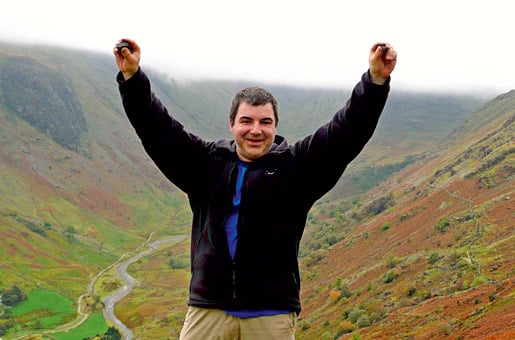
Figure 5. Back to the beginning. At the first ever graphite mines (Seathwaite, near Keswick, Lake District, England, 2009). After reaching Great Gable in nice, blasting Lake District weather, we finally got to the mines (just 50 meters away from the main road) to find plenty of graphite in the mine hillock.
In 2001, as many people finished their PhDs and postdocs, the community started to break up. Andre himself moved to Manchester early that year, and I didn’t hesitate for a moment when he invited me to join him, even though it meant leaving my PhD unfinished for the second time in a row. When I arrived in Manchester, it was to an empty room with one lock-in (still working), a turbo-pump (still there) and Sergey Morozov (still around), measuring ‘magnetic water’ while on a short visit to Andre. It was my third lab in less than three years and a different experience again: everything had to be built from scratch both in there and in the clean rooms (though I had less involvement with the latter), but this did allow for plenty of fun as everything was bespoke to our specific requirements.
Despite the fact that the lab then included only Andre, Irina Grigorieva, myself and a couple of other postdocs and visitors, the number of projects (in comparison to what I was exposed to in Nijmegen) hasn’t dropped. Probably even otherwise, besides mainstream projects like Irina’s cryogenic Bitter decoration [5] and mine and Andre’s domain wall motion in garnets [6], we were all involved in several others, including the mentioned ‘magnetic water’, mesoscopic superconductivity [7], gecko tape [8], scanning tunnelling microscopy (STM) with a gate electrode … the list was endless. In between the projects, I also managed to convince Irina Barbolina to marry me (over the phone, she was in Nijmegen at the time), and, with a PhD in microbiology, she joined the group for a few months, helping with biorelated experiments. We all enjoyed watching the turbulent life of yeast and other micro-organisms under a microscope during a project we dubbed “the last fart of a living cell” [9].
One of our projects, initiated by Andre, was an attempt to make a metallic field effect transistor. The choice of material, quite naturally, fell to graphite, mostly due to its low carrier concentration. I will skip giving a detailed description of the first stage of the project as Andre Geim describes the process in his lecture, but I thought I would just mention that we thought we would have to drop it altogether when Andre’s PhD student Da Jiang enthusiastically polished a piece of very expensive graphite into dust. The unexpected solution to the problem came from the scanning tunnelling microscopy project, which was led by Oleg Shkliarevskii.
At that time, I was doing very long measurements on domain walls, with magnetic field sweeps easily taking a day or more, so I was often hanging around the cold STM. Oleg was doing the first scans and showed me the way he cleaned graphite, by cleaving it with Scotch tape. Using Scotch tape (with residual flakes on it) taken literally from the dustbin, it took me less than an hour to produce a device which immediately demonstrated some miserable field effect; but, however small the effect – it was clear we had stumbled upon something very big (though I doubt at that time I realised how far it would go). We got onto it, and within a few months we had our first graphene device (sample ZYH-K51) [10].
The results we were getting were quite puzzling though, and I admit we got a great deal of help from theorists. I was organiszing our group seminars at the time and invited Dima Khmelnitsky from Cambridge to visit us. The seminar was due to start at 3 pm and Dima arrived at 7 in the evening, arguing that he calculated it should have taken him 3.5 hours to reach Manchester. Obviously, the seminar had to be cancelled, but we were able to spend the rest of the evening chatting about our recent results. When he heard about graphite, Dima immediately told us about the linear spectrum and pointed out (off the top of his head) that the Landau level quantisation for such a spectrum was considered in the problem to the paragraph on “Dirac equation for an electron in external field”, on page 148 of Quantum Electrodynamics (book four of the Russian edition of the Landau and Lifshitz course) – information which came just in time. Another piece of useful information came from Dima the very next morning, when he called me to confirm that his theory was correct and that he had reached Cambridge within 3.5 hours after having left Manchester at 4 am.
By 2004, my first postdoc was coming to an end, and I was actively searching for funding to allow me to continue in Manchester. I was granted a fellowship from the Leverhulme Trust, but they pointed out something unfortunate in the fine print: the recipient must have a PhD. I started running around like a headless chicken, searching for a body which would give me a degree within three months – with my project finishing soon and close to being kicked out of the country. I was extremely close to buying a so called ‘life experience’ PhD on the internet, but things came together, and I was awarded a PhD from Nijmegen – though even then things were touch-and-go as the company I was flying with went bust and my passport got stuck at the Foreign Office. Finally, after months of havoc, I was able to proudly phone the Leverhulme Trust to ask where to send my certificate. “We don’t want to see it,” they replied, “If you say you’ve got it, you’ve got it.” I was absolutely charmed with this kind of attitude.
In 2009, Irina’s and my bio-mechanical experiments paid off, and we produced a pair of amazingly good-looking samples: Sophia and Victoria. I sincerely hope that they will continue to work for many, many, many years.
Finally, the promised moral. Four of us (Andre Geim, Volodia Falko, Boris Altshuler and I) were sitting in a seminar room in Lancaster discussing our recent experiments on weak localisation in graphene. Volodia was telling us that it was unlikely that there was no weak localisation at all, and that we should measure better, and we were insisting that those were the facts and encouraging everyone to discuss the real physical situation and try to understand it. The truth, as usual, appeared to be somewhere in the middle, but the discussion became rather heated and even personal (as it often does between Andre and Volodia). Eventually Boris jumped up, ran away and brought back a poorly copied paper by Stark. It is really a bizarre reading on “The Pragmatic and the Dogmatic Spirit in Physics”[11]. It starts with, probably, the most concise description of how science should be done, and you are ready to sign under every single word until you turn the page, where … Well, let’s say Volodia turned out to be a bad guy (in the illustrious company of Einstein, Schrodinger and Heisenberg).
The moral is that it is impossible to learn the spirit of science from a textbook or article. They may be able to teach us physics and chemistry and many other disciplines at university, but it is up to us to develop a gut feeling for how best to ‘do science’. I am extremely lucky to have worked with and learned from Andre Geim, who is highly innovative and broad in his perspective but, at the same time, very truthful and critical of himself, with manic attention to details. It is so easy to lose sight of the bigger picture underpinning the details or get carried away with your ‘beautiful theory’ and stop paying attention to the facts; Andre is a master of finding the narrow path between these extremes, and, if there is one thing I am proud of in my life, it is that I have learned a little of this style.
This autobiography/biography was written at the time of the award and later published in the book series Les Prix Nobel/ Nobel Lectures/The Nobel Prizes. The information is sometimes updated with an addendum submitted by the Laureate.
Nobel Prizes and laureates
Six prizes were awarded for achievements that have conferred the greatest benefit to humankind. The 14 laureates' work and discoveries range from quantum tunnelling to promoting democratic rights.
See them all presented here.
